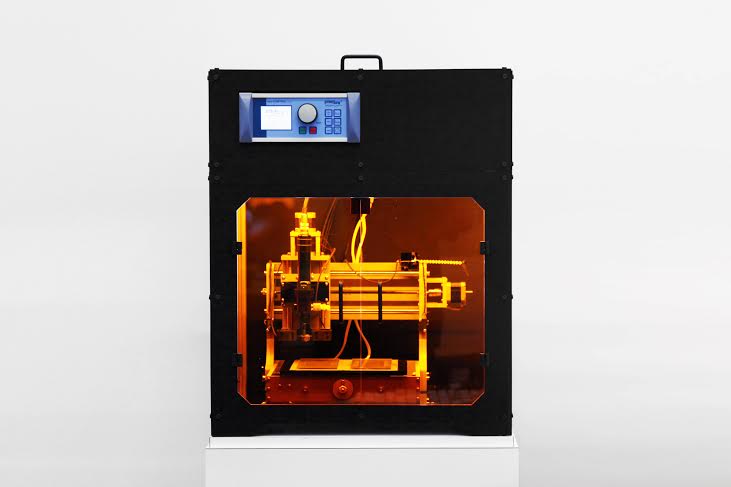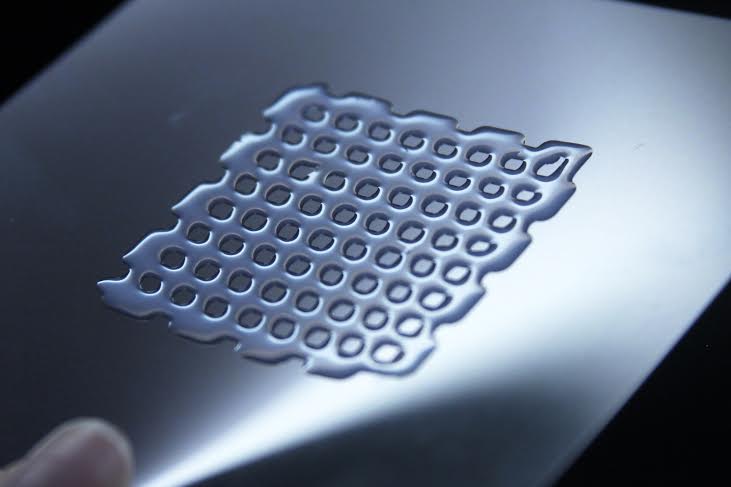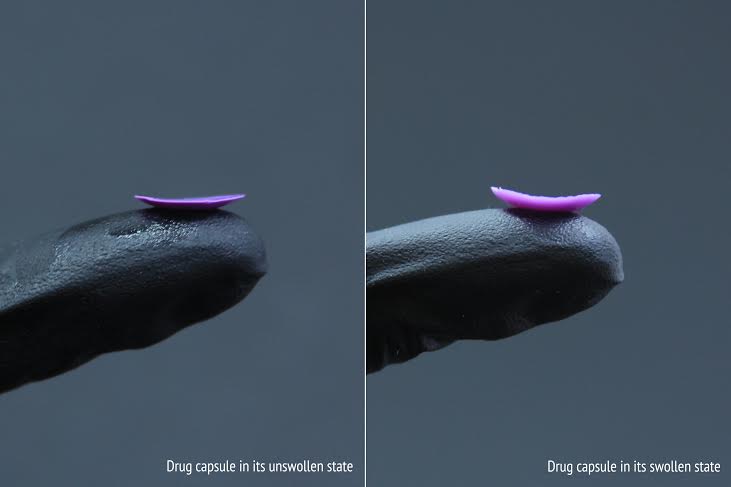 The brilliant minds have been working overtime at MIT again, much to our benefit. Coming from Tangible Media Group of the MIT Media Lab, which we just reported on recently regarding their ‘Materiable’ concept and study about shape changing interfaces, we’re taking a look now at a new project where these creative scientists will allow others involved in human computer interaction research to make their own technology as well.
The brilliant minds have been working overtime at MIT again, much to our benefit. Coming from Tangible Media Group of the MIT Media Lab, which we just reported on recently regarding their ‘Materiable’ concept and study about shape changing interfaces, we’re taking a look now at a new project where these creative scientists will allow others involved in human computer interaction research to make their own technology as well.
xPrint, the subject of the Tangible Media Group’s latest study, also doubles as the digital fabrication engine behind the team’s award-winning bioLogic project where they work to grow living actuators and synthesize ‘bio-skin’ that responds to its environment. They foresee these elements as being ‘grown rather than manufactured,’ striving to see these actuators and sensors as coming from nature rather than grim industrial factories.
The new machine is a modularized liquid printer for smart materials deposition. And while it sounds as if it will be doing very high-level work, the researchers worked to see that the xPrint could be made with ‘off the shelf or easy to machine’ parts, with their tools for CAD design and g-code generation developed using both Rhino and Grasshopper.
These findings were outlined in a recent paper, ‘xPrint: A Modularized Liquid Printer for Smart Materials Deposition,’ by Guanyun Wang, Lining Yao, Wen Wang, Jifei Ou, Chin-Yi Cheng, and Hiroshi Ishii. The idea was to help HCI work along further with a liquid based printing platform that is easy to make and assemble due to a modular design that allows for:
- Mechanical mixing
- Chemical reaction
- Light activation
- Solution vaporization
 Along with the simple yet clever modular design, xPrint also supports software that is open source for easy customization, meant to encourage construction of smart materials in a variety of applications.
Along with the simple yet clever modular design, xPrint also supports software that is open source for easy customization, meant to encourage construction of smart materials in a variety of applications.
The researchers foresee the uses for the printer and its varying materials as suitable not only for researchers and engineers, but also artists and fashion designers. All of this is relevant for HCI in that the materials used are within the 4D realm, offering intuitive and active forms that are able to respond to their surroundings and external stimulation, morphing into functional interfaces. Liquid-state materials were of interest to the researchers, but in finding the current choices to be too limited, they created an entirely new platform that would be compatible with ‘a wide range of viscosities’ and promote HCI research further. The researchers actually invited three users—a designer, scientific researcher, and an artist—to test the new system.
As the scientists were inspired by current work in the industry that delves into bioprinting, conductive materials, innovative new hardware for use with alternative materials, and open source, modular designs, the design for xPrint began to evolve. Offering numerous capabilities due to the specific modular components, the 3D printer is highly versatile.
“All modular components are designed with specific mechanical structures and magnet assemblies for easy plugging/unplugging and configuration,” state the researchers in their paper. “To save space and keep them clean, all components can rest on top of the ceiling of the printer case.”
The main features include:
- The dispenser – powered by central controls; can be turned on and off with customized G-code.
- Solution container – to be either a gravity-based container with no cap, or a closed container system used for materials with greater viscosity.
- Ventilation module – includes two-speed tuneable fans.
- Mechanical stir – to eliminate sedimentation.
- Camera – for remote tracking and live video stream of the printing process.
- UV curing lamp – for printing with resins.
- Pneumatic atomizer – for coating surfaces.
“xPrint focuses on printing smart, particularly active materials, which come in a liquid solution and solidify under particular chemical reactions or physical transformations,” state the researchers.
Four materials were chosen:
- Natto cells as RH responsive actuators – in combination with a water solution, the researchers came up with an origami like structure that bends and unfolds in response to the humidity in its environment.
- Calcium alginate as a pH responsive material – in combination with a calcium solution, the alginate forms a gel as the brush passes by the lines of liquid, allowing the 3D print to form in the traditional layering mode.
- Hydrogel swelling in water – used with a UV curable hydrogel, this material can actually swell up to 42% when submerged. Formation with the hydrogel is triggered by the UV radiation, releasing free radicals, and allowing the pre-polymer to become solid in mere seconds as UV light is used.
- Thermochromic film – changes color with temperature. The researchers stated that they ‘suspended commercial thermochromic powder into a water solution.’ After that they coated it, using the atomizer module.
Their three test users with no experience prior were given each 1.5 hours training on the whole system, and then were allowed to work on their own, with the assignment of designing their projects within two weeks.
Fashion designer Oksana worked with the Natto cell material to make a sweat-responsive fashion garment. Although some technological and operational issues occurred initially, she was quickly able to adjust so that each layer was printing correctly.
“After two weeks of intensively working on the garment, she mentioned that she now felt her colleagues back at her home school ‘are doing things that are so boring.’ She suggested that integrating responsiveness into fashion is very powerful, and the xPrint enables precise control of the film making process,” reported the research team.
Eve, a postdoctoral scientist, works in biological engineering and uses a variety of useful materials to research how living systems respond. She decided to print hydrogel capsules and study drug delivery effects.
“The biocompatible hydrogel has a dual function; first, it is a carrier of a sample drug that needs to be tested for toxicity in living cells,” reported the researchers. “Second, the swelling response of the hydrogel towards water is an interesting effect to study, and is related to the drug release rate.”
Eve’s hope was to make a simple type of instrument which would be able to show how the concept works, as well as measuring the gel volumes so that the rate of dosage would be accurate. In attempting also to 3D print a structure similar to a pill, she was challenged at first, forced to spend time adjusting the curing settings and printing. This only took about three hours, and upon success with making water-responsive capsules, she noted with surprise how simple the platform was, and stated that she did see how this could be ‘very useful’ as a low end printing system for science labs to use for testing purposes, and for using other materials as well.
The last user in the study was Samuel, a versatile freelance artist who had previously used thermochromic ink in his painting. Here, he used the color-changing capabilities for a ‘digital style color changing painting,’ employing both the dispenser and ventilation modules—along with their 1D tool for his line drawing. His project took two days total, to include the learning curve and the fabrication of the painting itself.
“He mentioned he felt a sense of ‘co-creation’ with the machine,” said the researchers. “He could never create a ‘digital but tangible’ drawing without the assistance of the machine. It was ‘like a copy you print out of your inkjet printer after you draw it in Illustrator,’ but it had a level of interactivity. When he commented on that, he placed his painting on top of a hot plate and demonstrated how the different components disappeared as he turned up the temperature.”
As the researchers continue to work on this technology, they’ve outlined areas they need to refine and explore further, such as:
- Fine-tuning the material properties and controlling the machine modules for printing.
- Improving the control axis and CNC moving speed.
- Further developing multi-material printing with a customized central dispenser.
- Sharing open source hardware and software.
After completing this comprehensive study, the researchers were able to conclude the that entire system is obviously more than viable for using a variety of modular designs with a range of materials. Their future hope is to see it operate as a ‘toolkit’ for those engaged in exploring and developing smart materials and working further on the 4D front with shape changing interfaces. Discuss this new technology further in the xPrint 3D Printer forum over at 3DPB.com.
Subscribe to Our Email Newsletter
Stay up-to-date on all the latest news from the 3D printing industry and receive information and offers from third party vendors.
Print Services
Upload your 3D Models and get them printed quickly and efficiently.
You May Also Like
3D Printing News Briefs, July 2, 2025: Copper Alloys, Defense Manufacturing, & More
We’re starting off with metals in today’s 3D Printing News Briefs, as Farsoon has unveiled a large-scale AM solution for copper alloys, and Meltio used its wire-laser metal solution to...
3DPOD 260: John Hart on VulcanForms, MIT, Desktop Metal and More
John Hart is a Professor at MIT; he´s also the director of the Laboratory for Manufacturing and Productivity as well as the director of the Center for Advanced Production Technologies....
3D Printing News Briefs, June 28, 2025: Defense Accelerator, Surgical Models, & More
In this weekend’s 3D Printing News Briefs, 3YOURMIND was selected to join an EU Defense Accelerator, and PTC has announced model-based definition (MBD) capabilities within Onshape. Finally, a study out...
EOS in India: AM’s Rising Star
EOS is doubling down on India. With a growing base of aerospace startups, new government policies, and a massive engineering workforce, India is quickly becoming one of the most important...






































